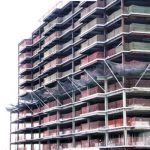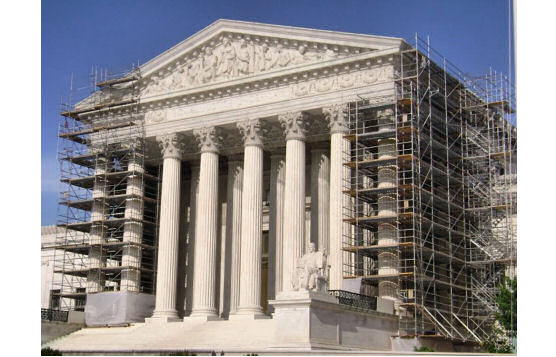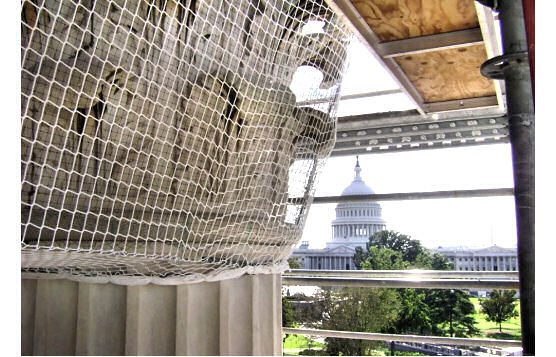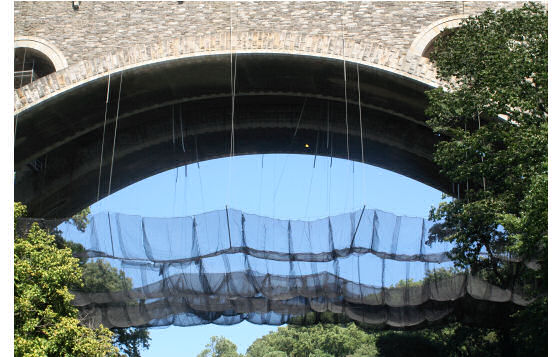Debris Netting Installation Will Arrest and Contain Falling Objects
Depending On The Application, Netting Liners Vary From Fine Mesh to Heavy Duty Mesh
 Debris netting is designed to catch falling objects, and the mesh size used in each project is based on the type of material required for the debris containment. FallProof provides full turnkey design and engineering and installation services for a variety of custom applications and solutions. Our installers frequently install debris netting during renovation and rehabilitation projects of covered bridges and historic structures, demolition or repair work on highway infrastructure or railroad trestles, bridge thoroughfares that are over water, and elevated workplaces on new construction of high-rise office buildings, hotels, resorts, condominiums, etc.
Debris netting is designed to catch falling objects, and the mesh size used in each project is based on the type of material required for the debris containment. FallProof provides full turnkey design and engineering and installation services for a variety of custom applications and solutions. Our installers frequently install debris netting during renovation and rehabilitation projects of covered bridges and historic structures, demolition or repair work on highway infrastructure or railroad trestles, bridge thoroughfares that are over water, and elevated workplaces on new construction of high-rise office buildings, hotels, resorts, condominiums, etc.
Debris Nets Eliminate Fall Hazards During Construction, Renovation or Rehabilitation
The following are the types of projects that eliminate fall safety hazards:
 Building Construction and Renovation – During construction and renovation projects, falling items such as bricks, concrete blocks and dropped tools have the potential to seriously injure pedestrians or cause damage to nearby property and passing vehicles. Our custom debris netting solutions prevent these items from becoming fall safety hazards. Debris containment is often achieved in combination with personnel fall protection, wherein a fine mesh liner is sewn inside a course mesh personnel-rated net. The liner is designed to catch small falling objects, whereas, the heavy-duty mesh provides the strength to stop heavy falling objects or personnel.
Building Construction and Renovation – During construction and renovation projects, falling items such as bricks, concrete blocks and dropped tools have the potential to seriously injure pedestrians or cause damage to nearby property and passing vehicles. Our custom debris netting solutions prevent these items from becoming fall safety hazards. Debris containment is often achieved in combination with personnel fall protection, wherein a fine mesh liner is sewn inside a course mesh personnel-rated net. The liner is designed to catch small falling objects, whereas, the heavy-duty mesh provides the strength to stop heavy falling objects or personnel.
Building Demolition –  FallProof has designed and installed special containment solutions for high-rise and other buildings that were scheduled for demolition. In one recent project, we installed a vertical “cocoon” around a 10-story building, allowing construction workers to demolish the building floor-by-floor from the top down. The system could be easily lowered to the next floor as each floor was demolished.
FallProof has designed and installed special containment solutions for high-rise and other buildings that were scheduled for demolition. In one recent project, we installed a vertical “cocoon” around a 10-story building, allowing construction workers to demolish the building floor-by-floor from the top down. The system could be easily lowered to the next floor as each floor was demolished.
Historic Buildings and Structures –  Debris containment netting can be added as a “second skin” or retention barrier around historic buildings and structures to catch or prevent falling objects, including fragments of statues, dislodged moldings and cornices and small pieces of masonry.
Debris containment netting can be added as a “second skin” or retention barrier around historic buildings and structures to catch or prevent falling objects, including fragments of statues, dislodged moldings and cornices and small pieces of masonry.
Bridges –  Debris netting can be used in several situations. First, our installers can install debris liners for personnel safety netting on bridges that are under construction, or undergoing renovation or maintenance. Secondly, FallProof designs and installs containment netting on older or covered or other historic bridges. A netting system is set up around and underneath to catch falling debris. These systems often must be engineered to avoid drilling into or causing any other permanent damage to the structure.
Debris netting can be used in several situations. First, our installers can install debris liners for personnel safety netting on bridges that are under construction, or undergoing renovation or maintenance. Secondly, FallProof designs and installs containment netting on older or covered or other historic bridges. A netting system is set up around and underneath to catch falling debris. These systems often must be engineered to avoid drilling into or causing any other permanent damage to the structure.
Where spalling concrete or other falling material becomes a problem, installation of debris netting can give the municipality or other owner additional years to design and fund a permanent solution. Where a low fall clearance and/or roads underneath exist, the netting is stretched tight beneath them. This allows cars, trucks and other vehicles to pass underneath without damaging the system.

Washington, D.C. - United States Supreme Court Building - In December, 2005, a modillion from the West portico pediment cornice failed and fell 80 feet to the entrance steps below. Following emergency repairs by Hitt Contracting, FallProof installed a retention barrier to protect against future failures while a permanent solution could be developed. The full restoration was completed in 2013.

This project demonstrated one of the most useful applications of a debris net. The initial instance of falling mortar occurred in 2005, and it was not until eight years later that the restoration was completed. Wrapping the weakened structure in nets kept the historic area safe while providing time for the logistical details to be worked out.

Boonton, NJ - Boonton Railroad Bridge - This solution was installed under the bridge for the workers who were replacing railroad ties on the rail line above, and prevented both personnel and construction material from falling into the Rockaway River below. As always, FallProof came in on time and on budget.

A fine mesh liner is often used with either personnel or debris-only nets during rail bridge maintenance to prevent pieces of creosote-soaked railroad ties from falling into and contaminating the water below. Here, we used our WS-70 liner with a 1/8” square mesh. Both larger and smaller mesh sizes are available.

East Hampton, CT - The Historic Comstock Covered Bridge - This bridge, built in 1840, spans the Salmon River north of Route 16 and consists of two distinct sections. The 80-foot main span is a Howe truss, which combines vertical iron rods and diagonal timbers and was widely used in railroad construction, as well as for highways and factories.

The 30-foot east span is the only remaining example in Connecticut of an enclosed, wooden pony truss – one with no overhead roof or other bracing. Due to its historic nature, no damage to the structure was allowed, so we designed and fabricated special non-penetrating brackets and outrigger arms to cantilever the nets over the stream.

Ft. Lee, NJ – George Washington Bridge - These nets were installed around the walkway during work to replace a water pipe and prevented tools and other items from falling into the Hudson River. They were manufactured and installed within a short time to accommodate the prime contractor’s schedule.

The Port Authority of New York and New Jersey closed the traffic lane adjacent to the walkway during installation. As is customary on this type of job, temporary fall protection systems were used by our crew while installing the system from the walkway.

Philadelphia, PA - The Henry Avenue Bridge Project - Also known as the Wissahickon Memorial Bridge, this masterpiece was completed in 1932 and listed on the National Register of Historic Places in 1988. The main span of this open-spandrel structure is 288 feet long. The original design called for a lower level for a subway line that was never built.

Our services included the engineering, design and installation of a 33,000 square foot debris containment system for use during rehabilitation of the bridge. This provided protection for pedestrians in Fairmount Park and drivers on Lincoln Drive, both of which are located above Wissahickon Creek.

The 170-foot roadway height prevented the use of any lifting equipment from the ground below. This required a design that allowed the nets to be deployed from above by utilizing specially fabricated brackets and cabling with suspended outrigger arms. The system was engineered to withstand high winds, as well as possible snow and ice loads.

Bronx, NY – Harlem River Lift Bridge - The current Metro North lift bridge spanning the Harlem river is the third rail crossing at the site. It was completed in 1956, replacing an 1890’s swing bridge, which had replaced an 1841 span. It is a vital link to Manhattan for the 280,000 passengers and 750 trains that cross it each workday.

This installation was unique in that it was the first time the MTA used nets as the primary fall protection solution for rail workers. The MTA was performing track replacement on the rail lines, and our design increased efficiency by allowing the workers freedom of movement since they no longer had to be tied off.

Work was done from an 80-foot lift mounted on a spudded barge anchored in the Harlem River. Doing all of the work from below in this manner allowed the railroad operations to continue completely uninterrupted, as none of the FallProof workers ever had a need to be on the track level.

Having the nets close to the railroad ties being replaced has two advantages. First, if a worker falls, rescue consists of merely stepping back up to the track level. Second there is no distance for momentum to increase the speed of a falling railroad tie, so the support structure for the nets is reduced.

East Orange, NJ - Old East Orange Police Barracks - A 100-year old incinerator smokestack located at the East Orange, New Jersey police station is in disrepair and in need of demolition. Because bricks were falling off and the city did not have the funds budgeted to immediately demolish the structure, FallProof was called in to install containment nets to protect pedestrians at street level.

Because the smokestack did not have the structural integrity to support the weight of the nets and cable, no drilling into the smokestack was allowed by the structural engineers. To overcome this problem, FallProof designed custom attachment brackets that allowed the system to be hung from the top rim, resulting in all force being straight down rather than outward.

Jersey City, NJ - Pulaski Skyway, Hudson Viaduct Section - This custom solution to protect a half-mile long, four-lane highway, required each net to be a specific size and shape. Each component was numbered to facilitate installation one lane at a time, and no part of the system could encroach more than two inches into the roadway.

Brackets were designed and fabricated by FallProof that allowed cable to be strung above the bottom of the trusses supporting the weight of the upper roadway. FallProof and its structural engineers provided design and engineering for the entire system, which was reviewed and approved by engineers for both the NJ Department of Transportation and the prime contractor.
Click to Call
or
dial us at 1-(855) 279-2000
The following are clients we have provided these services for. Call us to learn more about the solutions we offer. Whatever your need or application, from purchase to short or long-term netting system rentals, we have you covered.
- City of Philadelphia (Henry Avenue / Wissahickon Memorial Bridge, Philadelphia, PA)
- New Jersey Department of Transportation (Pulaski Skyway)
- New Jersey Transit (Boonton Railroad Bridge, Boonton, NJ)
- New York City Department of Transportation (138th Street Bridge / Lift Bridge), Bronx, NY)
- Oklahoma Turnpike Authority (Vinita Interstate 44 Service Plaza Overpass)
- Port Authority of New York and New Jersey (George Washington Bridge, Ft. Lee, NJ)
- Southeastern Pennsylvania Transit Authority / SEPTA (Miscellaneous Bridges)
- State of Connecticut (Comstock Covered Bridge, East Hampton, CT)
 Debris netting is designed to catch falling objects, and the mesh size used in each project is based on the type of material required for the debris containment. FallProof provides full turnkey design and engineering and installation services for a variety of custom applications and solutions. Our installers frequently install debris netting during renovation and rehabilitation projects of covered bridges and historic structures, demolition or repair work on highway infrastructure or railroad trestles, bridge thoroughfares that are over water, and elevated workplaces on new construction of high-rise office buildings, hotels, resorts, condominiums, etc.
Debris netting is designed to catch falling objects, and the mesh size used in each project is based on the type of material required for the debris containment. FallProof provides full turnkey design and engineering and installation services for a variety of custom applications and solutions. Our installers frequently install debris netting during renovation and rehabilitation projects of covered bridges and historic structures, demolition or repair work on highway infrastructure or railroad trestles, bridge thoroughfares that are over water, and elevated workplaces on new construction of high-rise office buildings, hotels, resorts, condominiums, etc. Building Construction and Renovation – During construction and renovation projects, falling items such as bricks, concrete blocks and dropped tools have the potential to seriously injure pedestrians or cause damage to nearby property and passing vehicles. Our custom debris netting solutions prevent these items from becoming fall safety hazards. Debris containment is often achieved in combination with personnel fall protection, wherein a fine mesh liner is sewn inside a course mesh personnel-rated net. The liner is designed to catch small falling objects, whereas, the heavy-duty mesh provides the strength to stop heavy falling objects or personnel.
Building Construction and Renovation – During construction and renovation projects, falling items such as bricks, concrete blocks and dropped tools have the potential to seriously injure pedestrians or cause damage to nearby property and passing vehicles. Our custom debris netting solutions prevent these items from becoming fall safety hazards. Debris containment is often achieved in combination with personnel fall protection, wherein a fine mesh liner is sewn inside a course mesh personnel-rated net. The liner is designed to catch small falling objects, whereas, the heavy-duty mesh provides the strength to stop heavy falling objects or personnel. FallProof has designed and installed special containment solutions for high-rise and other buildings that were scheduled for demolition. In one recent project, we installed a vertical “cocoon” around a 10-story building, allowing construction workers to demolish the building floor-by-floor from the top down. The system could be easily lowered to the next floor as each floor was demolished.
FallProof has designed and installed special containment solutions for high-rise and other buildings that were scheduled for demolition. In one recent project, we installed a vertical “cocoon” around a 10-story building, allowing construction workers to demolish the building floor-by-floor from the top down. The system could be easily lowered to the next floor as each floor was demolished. Debris containment netting can be added as a “second skin” or retention barrier around historic buildings and structures to catch or prevent falling objects, including fragments of statues, dislodged moldings and cornices and small pieces of masonry.
Debris containment netting can be added as a “second skin” or retention barrier around historic buildings and structures to catch or prevent falling objects, including fragments of statues, dislodged moldings and cornices and small pieces of masonry. Debris netting can be used in several situations. First, our installers can install debris liners for personnel safety netting on bridges that are under construction, or undergoing renovation or maintenance. Secondly, FallProof designs and installs containment netting on older or covered or other historic bridges. A netting system is set up around and underneath to catch falling debris. These systems often must be engineered to avoid drilling into or causing any other permanent damage to the structure.
Debris netting can be used in several situations. First, our installers can install debris liners for personnel safety netting on bridges that are under construction, or undergoing renovation or maintenance. Secondly, FallProof designs and installs containment netting on older or covered or other historic bridges. A netting system is set up around and underneath to catch falling debris. These systems often must be engineered to avoid drilling into or causing any other permanent damage to the structure.



















